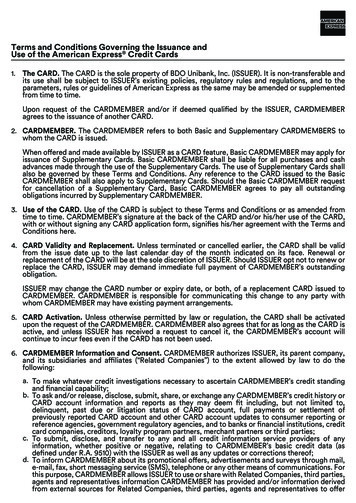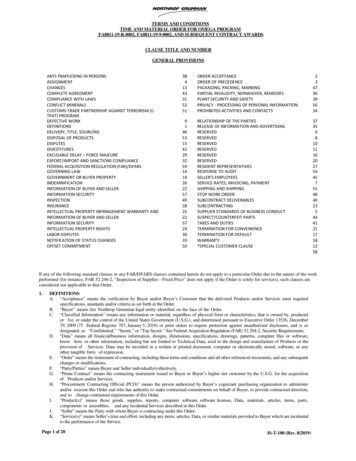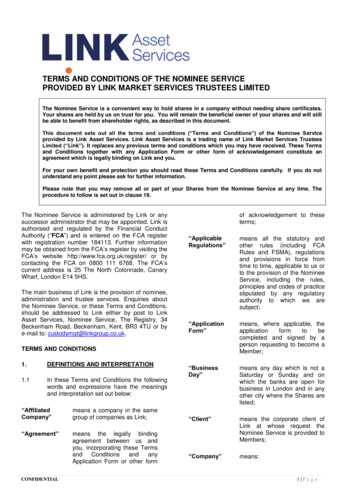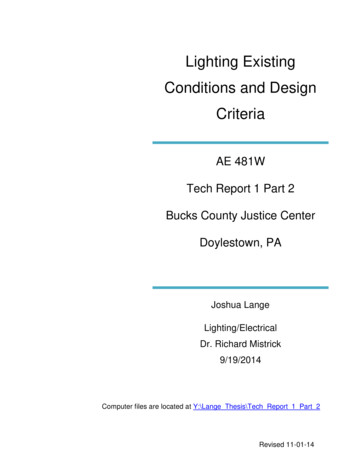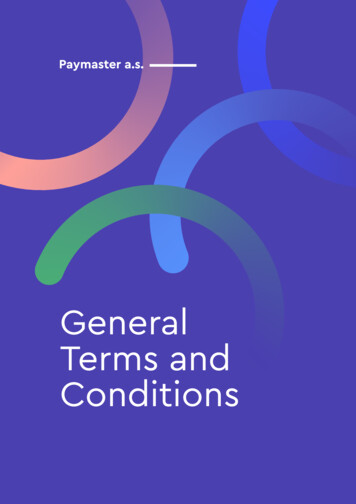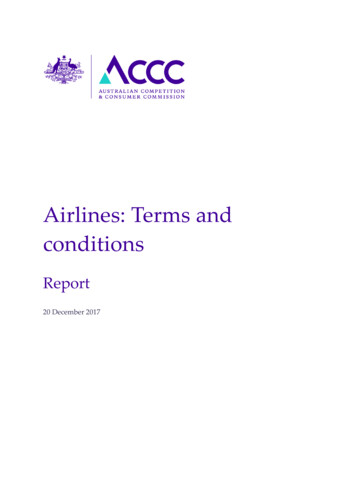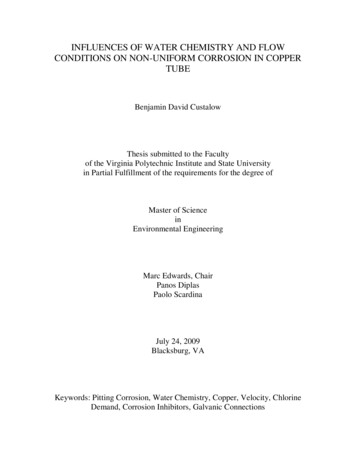
Transcription
Drought conditions and management strategies in ZimbabweS. S. NangombeMeteorological Services Department, Harare, Zimbabwe, ssnangombe@yahoo.comBackground:Agriculture in Zimbabwe contributes to 19% of the country’s GDP. Approximately 80% ofZimbabweans depend on this agriculture which is mostly rain fed for their livelihoods (Madzwamuse,2010). Once, Zimbabwe was a food exporting nation with the country recording surpluses in foodproduction almost every year. In recent years, the nation’s crop production largely declined and one ofthe main contributing factors of this has been attributed to erratic and sub-normal rainfall amounts. Overthe past decade, the amount of rainfall the country receives has deviated from the multi-decadal mean ona regular basis (UNEP, 2010). On the later part of the 20th century, runoff in the country decreased by 20to 30% (MMET, 1998).Of late, droughts have been crippling the nation and have contributed to the already low life-expectancylevels and high levels of emigration. During the drought of the 1991/1992 season, for example, maizeproduction decreased by almost 75 percent leaving a large percentage of the population in dire need offood aid. The Grain Marketing Board (GMB) domestic maize intake during the 1992 drought year wasabout 13 000 tonnes - just enough for two days consumption for the nation. Over one million head ofcattle died of starvation during the year. Drought returned in 1993 and 1994 2002, 2004 and 2012 seasonswhich also affected livelihoods. . The 2012 drought saw a deficit of approximately 45 per cent in thenation’s staple food source, maize, (FDI Global Food and Water Security Research Programme, 2012).About 1.4 million Zimbabweans faced famine in 2012 (FDI Global Food and Water Security ResearchProgramme, 2012). The cumulative occurrence of these droughts in rural Zimbabwe since 2002 hasculminated in the stagnation of rural livelihoods which have enormously been agro-based. Thisdeliberation has not only entrenched rural poverty, but, has seen the introduction of new strategies suchas conservation farming and food handouts, all of which have failed to usher into a natureofthesolutions.
Table 1: Droughts in Zimbabwe between 1950 and 2013ExtremeSevereMild droughtGradeDroughtdroughtFlood/Drought years1983,19921968, 1973,1982, 20041951, 1960, 1964, 1965, 1970, 1984, 1987,1991, 1995, 2002, 2003, 2005 , 2007, 2008,2009, 2010Total23.3%46.7%1626.7%Although the bulk of the drought years were mild drought, this also had an effect on the people’slivelihoods, especially in rural areas.Fig 1: Time series showing the extreme rainfall years in ZimbabweThe last two decade 1990-2000 and 2000-2010 shown in figure 1 had more years in the droughtcategory than other decades.Drought monitoring and early warning systems:Drought monitoring in Zimbabwe is carried out by two main ministries, the Ministry ofEnvironment, Water and Climate through the Meteorological Services Department (MSD) andministry of Agriculture through Agriculture Research and Extension Services (AGRITEX). Theroles and responsibilities of the two organizations include systematic observation and monitoringof hydro-meteorological parameters; provision and publication of information, forecasts,products and services related to weather and climate. Also these departments are responsible forthe supply of data related to drought-relevant parameters, indices and indicators. The earlywarning system for drought in Zimbabwe at the national level is not very effective if not nonexistent. This is the most overlooked area since so far there is no substantial establishment of avisible structure to that effect, yet it is the starting point for drought preparedness. It follows thatif there are effective monitoring and drought forecasting, then adaptive capacity can be enhanced
hence the management program becomes proactive rather than reactive. It was only on paper buthas not been put into practice.The Meteorological Services Department provides early warnings to the people for drought fromthe time it starts disseminating the seasonal forecast. The seasonal forecast is generated bysouthern Africa regional climate experts together through the regional forum called the SouthernAfrica Regional Climate Outlook Forum and disseminated in August prior to the rainfall season.Each member state then downscale the regional forecast to their national level. Then the droughtstatus is monitored as a continual process as the season progress hence this can pick out the intraseasonal droughts that may have been missed by the seasonal forecast. The MSD uses theStandardised Precipitation Index which qualifies the severity of droughts in drought monitoring.AGRITEX also does drought monitoring by going further into getting the water requirement forthe crops and livestock through the use of temperature, soil quality, evapotranspiration andrainfall. They mainly use the Water Requirement Satisfaction Index (WRSI) in droughtmonitoring. It is these two institutions who will advise the government on the country’s droughtstatus and also are both members of the Zimbabwe’s National Early Warning Unit (NEWU)which makes coordination and dissemination of information efficient.Vulnerability assessment:Zimbabwe’s drought vulnerability situation is represented every year through the ZimbabweVulnerability Assessment (ZIMVAC) report which outlines the vulnerability areas and groups.Droughts have been by far the most significant threat to Zimbabwe compared to other naturaldisasters with huge economic, environmental and social costs. Agriculture (crop, livestockforestry and fishery), depends heavily on water hence if sub-normal rainfall is received, it mayconsequently lead to loss in crop yields or livestock production and increase in insectinfestations, wind erosion or forest fires which all have serious negative effects on the nationaleconomy.The agricultural sector is usually the first one to be affected by droughts, given its dependence onsoil and water, which can be rapidly depleted during extended dry periods. The approximately80% of the total population which depends on agriculture in Zimbabwe are the ones mostsusceptible to shocks from drought occurrences. More than half of the population live in ruralareas where the general quality of living is low and are less prepared to deal with problemsbrought about by droughts. Moreover, it’s the children and woman who are most affected ascompared to men whom most work in towns. Prolonged dry spells and/or droughts affect othersectors relying on alternative water. Sectors using surface water like lakes and dams andsubsurface water are usually the last ones affected. The dryness of the environment due todroughts will also substantially increase the risk of forest fires which compromises the safety ofboth human and wildlife populations especially in the rural areas again where they are lessprepared to deal with such disasters.
Emergency relief and drought response:The Rural District Council (RDC) in some communities in Zimbabwe has through negotiationsand partnership with NGOs such as CARE Zimbabwe and the World Food Program engaged thelocal government to use Grain Marketing Board storage facilities for the grain stocks. Theimportance of a grain reserve stock in case of moderate to severe drought is very important fordrought response preparation. The proposed reserve stock would serve as relief in the case ofoccurrence of drought. Such a minimum reserve stocks policy would avoid delayed importation,since the responsibility for this exercise and provision of funds will lie in the hands of the RDCthrough the Local Government. Also the government’s initiated District Development Fund alsowas given the responsibility to erect boreholes in drought prone rural communities. Theseboreholes have assisted the people and livestock in providing water whenever droughts hit.However, it was noted that if the drought is prolonged, this has a tendency of also drying up theboreholes in these areas.Furthermore, development partners (NGOs) come in to support government throughimplementing projects that address drought extreme conditions by providing food aid and waterto different affected communities. Livestock are also extremely affected by droughts especiallythose of long duration. The Vet Field Services Department also works in collaboration with FAOin providing supplementary feeds for livestock in affected areas. However, the government ofZimbabwe has the major role in emergency relief and drought response with the Ministry ofAgriculture taking the leading role. Development partners (NGOs) come in only to supportgovernment through implementing projects that address the extreme conditions such as thesedroughts by providing food aid to different communitiesPractices to alleviate drought impacts:Chipindu (2008) confirms that conservation is not only an essential aspect of development, butdrought management too. Alternative energy sources such as jelly oil, paraffin and solar werebeing distributed to households in the community on condition that they were willing toparticipate in the drought management program. Again, livestock that are ecologically viable andprovide tillage such as donkeys and goats were promoted. Moreover, people were encouraged touse organic manure as fertilizer rather than relying of inorganic fertilizers which have negativeimplication for the productive capacity of the soil. This is complemented by the technocraticapproach to disaster management which recommends that disaster management efforts should beproactive based rather than being reactionary. It follows that, if drought management follows thisrecommendation, it would be easy to cope with through the community’s mitigation efforts intheir adoption of conservation practices.The following practices are encouraged especially in severe drought prone areas:-Conservation agriculture-Climate Change Adaptation projects (Bee keeping, livestock, etc)-Promotion of small grain drought tolerant crops-Promotion of short season varieties-Water harvesting techniques-Irrigation
Farmers, especially communal small holder farmers through AGRITEX are advised not only torely on indigenous knowledge on seasonal forecast but to in-cooperate more the scientificseasonal forecast issued by MSD. Other scientists argue that the indigenous indicators, such asthe physiological behavior of trees, behavior of frogs and sounds of birds, are related to theresponse of certain animals and plants to the already prevailing weather stimuli, rather than thecoming season.The need for knowledge and skills on drought management:Studies in Zimbabwe are indicating that smallholder farmers are increasingly concerned aboutunfamiliar climate dynamics, including uncertainty about planting, loss of crops and damage toinfrastructure (Zvigadza et al, 2010). The same farmers highlight the lack of access to weathertrends and climate data. There is need for the MSD to embark on nationwide awarenesscampaign to conscientise farmers on how to use weather and climate products and also where toget this information. In the past, drought relief programmes have suffered from four majorshortcomings. First, there has been no adequate definition of drought so that drought declarationhas been determined by practical experience and observation rather than a scientific process.This has resulted in frequent national drought declarations, and extensive relief programmes,when only part of the country has been affected. Second, the Government has borne theresponsibility for risk management and has financed and delivered substantial relief programmesduring drought. This has discouraged farmers from adopting risk minimizing farming practices.Third, a number of drought programmes, like the fodder subsidy, have led to unsustainablefarming practices. Finally, vulnerable group food distribution programmes during drought havebeen inefficient, poorly targeted, and of limited impact in ensuring household food security(Chitongo, 2013).Several Studies have been done in Zimbabwe’s communal areas. For example, (1) Coping withdrought and Climate Change (Unganai); (2) Building Adaptive Capacity to Cope withIncreasing Vulnerability due to Climate Change (ICRISAT) and many others show a lack ofcapacity and leadership in local government around climate change adaptation. Strong localinstitutions are a critical success factor for adaptation. Environmental change is dynamic, so newchallenges will always be emerging. These challenges require well-resourced institutions. Thepressing need is to establish a drought early warning system at national and local level.Furthermore, the country would highly benefit from the following: Upgrading and modernizing the hydro-meteorological observation networks, datamanagement and forecasting system as well as supporting sustainable organizational,human and technical resources to maintain and operate them; Training in drought vulnerability and risk assessment; Enhancing the cooperation and networking between various hydro-agro-meteorologicalsectors, different stakeholders and end-users of this data, services and early warnings; Strengthening the capabilities for drought preparedness and management, includingcontingency plans at local and national level; and Developing sustainable irrigation systems.
ReferenceChipindu, B. 2008. ‘Possible Causes of Drought in Southern Africa’. In the Report of the sixth SouthernAfrica Regional Climate Outlook Forum. 23-24.Harare. SADC Drought Monitoring Center.Chitonga, L. 2013. Towards Comprehensive Disaster Risk Management in Zimbabwe: EvaluatingMasvingo Rural District’s Community Drought Management Program: International Journal of Economy,Management and Social Sciences. 644-653FDI Global Food and Water Security Research Programme, atersecurity-outlook.htmlMadzwamuse, M. (2010). Climate Governments in Africa: adaptation strategies and institutions. Asynthesis report prepared for the Heinrich Boll Foundation.Ministry of Mines, Environment and Tourism (MMET) (1998). Zimbabwe’s Initial NationalCommunication on Climate Change under the UNFCC.Unganai, L (2012). Coping with drought and climate change.Zvigadza, Sherpard et al (2010). Building Local capacity for Adaptation in Goromonzi District,Munyawiri Ward, Zimbabwe. A report through the Community Based Adaptation in Africa project,funded by IDRC and DFID. Accessed in April 2011.
Table 1: Droughts in Zimbabwe between 1950 and 2013 Grade Extreme Drought Severe drought Mild drou



